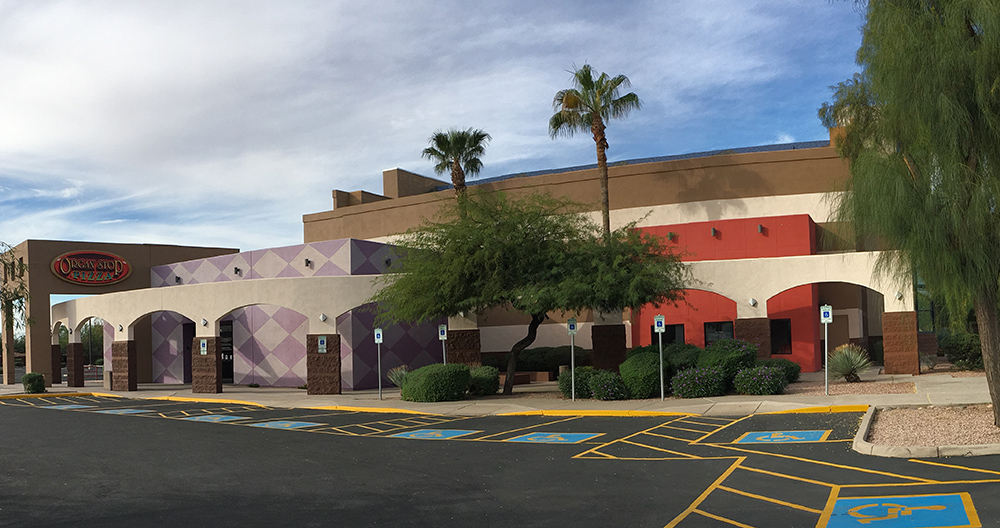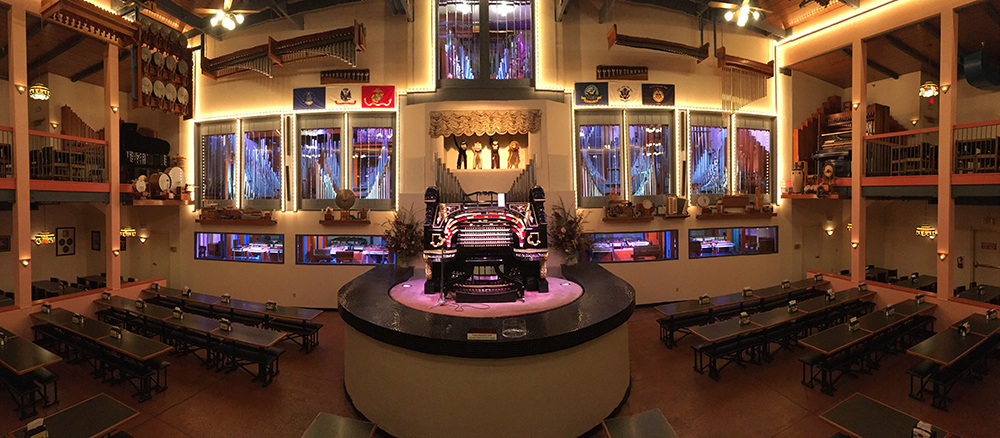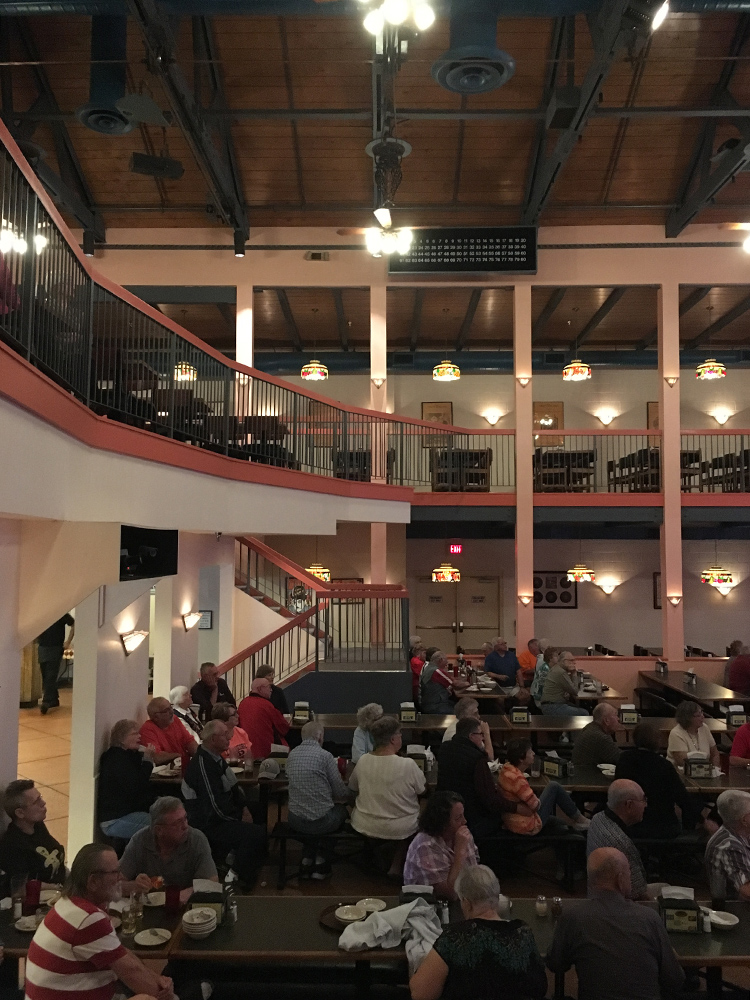Pizza and Pipes
Mesa, Arizona’s Organ Stop Pizza offers one of the most unique dining experiences in the country by serving its food with a heaping side of organ music. Owner Jack Barz discusses his iconic restaurant and its main attraction, the world’s largest Wurlitzer pipe organ, which has been entertaining customers for over four decades.
Tell us a little about yourself. Did you grow up in Arizona? How did you get involved with Organ Stop Pizza?
In the summer of 1973, I moved to Mesa, about two blocks away from where the original Mesa Organ Stop Pizza would open in the summer of 1975. I was six years old the first time I went to Organ Stop and loved eating there. I applied as a dishwasher the summer I turned sixteen. During my senior year, I was promoted to crew supervisor, and that’s when my love of the hospitality business started. I decided to get a degree in hotel and restaurant management from Northern Arizona University, but I continued to work at Organ Stop during school breaks and was hired as a full-time manager upon graduation. That was about the same time the owners decided to build the current location and needed to add to the ownership group.
How did a 1927 Wurlitzer organ become the focal point of your business?
When Organ Stop first opened in 1975, the intention was always for the Mighty Wurlitzer to be the star of the restaurant. We really are an entertainment facility that serves pizza as a source of income. As we’ve continued to improve the instrument throughout the years, the organ has become a personality in its own right. The Wurlitzer in the Mesa shop came from the Denver Theatre. The vast tonal resources it possesses are unmatched by any other musical instrument. In fact, because of the tonal range from low to high, it is actually one of the most difficult instruments in the world to record.
How long did it take to set up the current organ system? What sorts of additions or refinements have you made over the years?
We spent about four months installing the organ in our current location. We were a team of about twelve, working seven days a week, usually between twelve to fourteen hours every day. Every pipe had to be individually removed, packed, moved, unpacked, and eventually retuned. The day we opened at this location, we had fifty-one ranks (sets) of pipes operating. With our most recent addition of an eight-foot principal and three-rank mixture, the organ is now at a staggering eighty-two ranks, for a total of nearly six thousand pipes, making it not only the largest Wurlitzer in the world but also the largest theatre organ of any type ever assembled.
The major additions we’ve made over the years include the current console, which was built for us in 1997. It is an exact replica of the largest console ever created by Wurlitzer that was installed at Brooklyn Paramount Theatre. We’ve also been able to acquire a set of thirty-two-foot diaphones that Wurlitzer only made twelve sets of. We also have a percussion called the tuned tympani, and Wurlitzer only made three total units of those. Our goal for increasing the size of the instrument is to add color and dimension to what we already have; we do not increase ranks just for the sake of making it larger.

The acoustics of your building, which is more of a warehouse size, would also seem to be important to the sound. Did you want a space with high ceilings, for example, to maximize the musical experience?
This building was built exclusively for the organ to “speak” into the dining room for maximum acoustical pleasure. Several architects, sound professionals, and organ builders worked together to design an area that allowed the sound to build and have an area that we could serve our customers. There is not a square inch of the dining room/performance area that was not thought out completely.
How do you go about choosing organists? How many do you employ?
We have a staff of four incredibly talented musicians, and each brings a different dimension to the musical performance. They all have their specialties. For example, Charlie Balogh is a master of the Jazz/Big Band era, and Lew Williams plays some classical pieces like a one-man symphony orchestra. With the theatre organ world being a pretty small community, any qualified organists are well within our sights and have either played here as a substitute or have been around long enough that we know of their capabilities. We have a list of people who would love to have the chance to play our Mighty Wurlitzer on a regular basis. That’s just how special this instrument is. It’s something we are extremely proud of.
What kinds of visuals accompany the music to wow the audience?
Part of the Organ Stop experience is a visual show to accompany the music. Most of the tuned and untuned percussions are hung in the dining room rafters or on the walls for greater audience appeal. Several lighting effects have been added throughout the years, along with military and American flags and bubbles that magically descend from the rafters. We also have a custom three-foot disco ball to help entertain our audience. Our most popular effect, though, is the world famous Dancing Alley Cats. These four kitty puppets have been our most popular staff members for thirty years running. In addition, our organists control all the theatrical and lighting effects, so they’re not only the conductors but also the entire band and orchestra, the lighting and stage engineers, and the production crew. They wear many hats while performing every night.

How many customers do you welcome on a given night? How many people visit every year? Are there times or events that draw even bigger crowds?
We’re a very seasonal restaurant. Our crowds quadruple during the high season of winter compared to our slower season, which is late summer to early fall. The nightly customer count is about is about five to six hundred. We seat seven hundred people and often turn over the dining room three or four times per night during the winter. Our busiest times coincide with high tourist season, which includes Thanksgiving weekend, the week between Christmas and New Year’s, and spring break. We are one of the most popular tourist destinations in the East Valley of Phoenix, so we are typically the go-to attraction for out-of-town guests. Most years, we serve about 250,000 guests.
What are the most requested songs? Most unusual? Do your organists ever get stumped?
The majority of the musical program is based on audience requests, and there certainly are some pieces of music that do not lend themselves well to the theatre pipe organ, so they are not played. By far the most popular request is the Phantom of the Opera theme song. Other popular requests are “Alley Cat,” “Chattanooga Choo Choo,” Disney pieces, patriotic pieces, and “Bohemian Rhapsody,” or, as someone requested one night, “Bohemian Rap-City.” One of the most unusual requests is “In a Gadda da Vida.” That piece has a cult-like following.
There are several pieces (usually newer music) that our organists are just not familiar with, so those requests generally are not played. With that in mind, one of our organists, Brett Valliant, always has his smartphone with him at the console for that reason. If he receives a request for an unfamiliar piece of music, he listens to it live while he plays it. He is usually playing about three measures behind what he is listening to. It’s quite extraordinary! All of our musicians are so immensely talented; it really blows my mind what they are capable of producing from our Mighty Wurlitzer. Even after thirty years of listening to them, they always surprise me with their musicality.

As amazing as the music is, people wouldn’t go if the food weren’t good, so tell us a little about it:
We certainly wouldn’t be operating for over forty years if we weren’t serving high-quality meals to our guests. I think one of the things that makes our pizza stand out is the amount of cheese and toppings we pile high on our pizzas. So many other pizza restaurants have continued to reduce the amount of toppings, and we have always maintained that pizza should be a filling dinner experience that doesn’t leave you hungry an hour later. The amount of cheese, meat, and fresh vegetables we top each pizza with will leave you satisfied for hours. We also serve an excellent gluten-free pizza that people rave about, and we serve a variety of appetizers, pasta dinners, and sandwiches, and we have a full salad bar.
What else makes Organ Stop Pizza such a memorable dining experience?
Organ Stop is definitely in a class of its own when it comes to the restaurant world. We are a destination stop more than a spur-of-the-moment dining experience, which is one reason we are only open for dinner to the public. However, we are also available for private lunches for groups of fifty or more people. This gives us the opportunity to host school field trips, company parties, business customer appreciation lunches, church groups, and our most frequent groups—people staying at RV resorts.
During the winter months, when the Phoenix metro area is filled with winter visitors, Organ Stop often has two private lunches booked every day from January through March. During that time period, people visit us from all over the US and Canada. We also have guests visit from various parts of the world, including many European countries, as well as Asia, Africa, and Australia.
What does the future look like for Organ Stop Pizza?
We’ll continue to add rare sets of pipes if any become available, and we are always looking at ways to add to the theatrical portion of the show. Technology plays a huge role in the theatrics available to us. Many lighting effects are now LED-based, so power consumption is much lower than before, meaning we can add to the lighting effects without needing to meet any additional power requirements.
As far as the restaurant itself, we are going to continue to grow with the local market. We constantly hear from folks throughout the country asking us to expand into their area. It would be great to be able to build in other areas, but, unfortunately, there are not that many high-quality organs available anymore, and we really are not looking to expand out of this area. We’re happy with what we have going on here in Mesa.
For more info, visit organstoppizza.com.
Up Next:
Craft Your Own Harvest Pizzas


Posted in Feature, Issue 85 Vol 1 on Jul 07, 2017